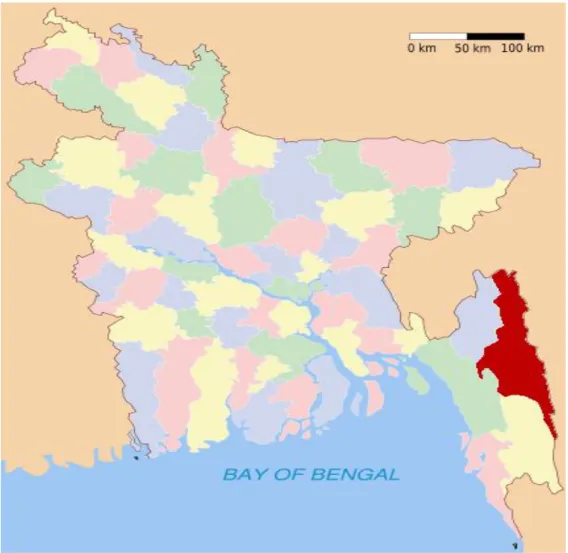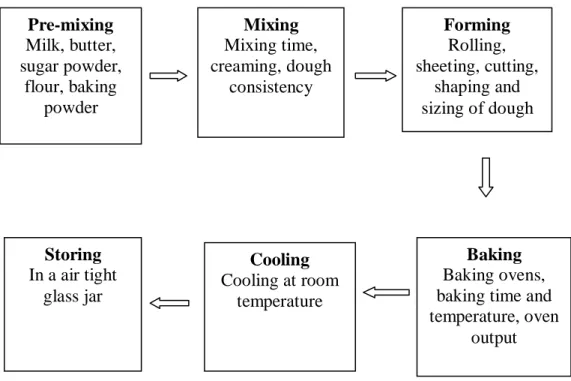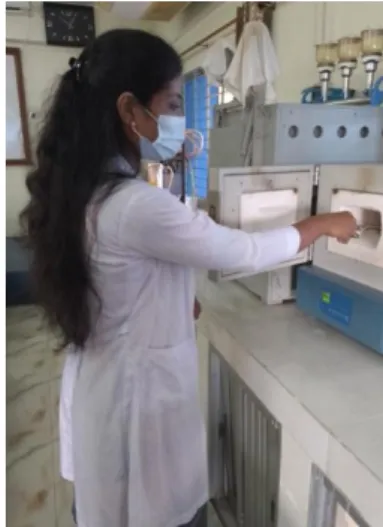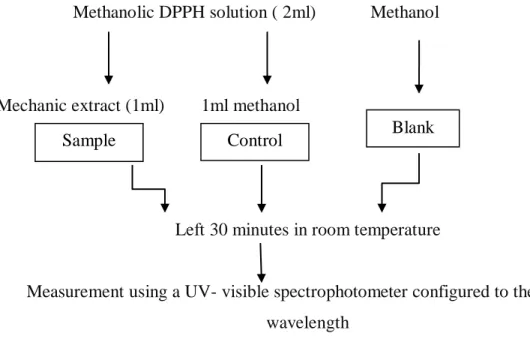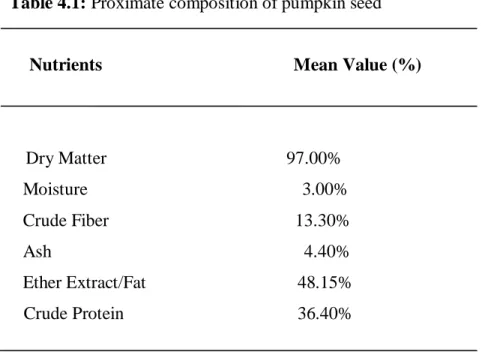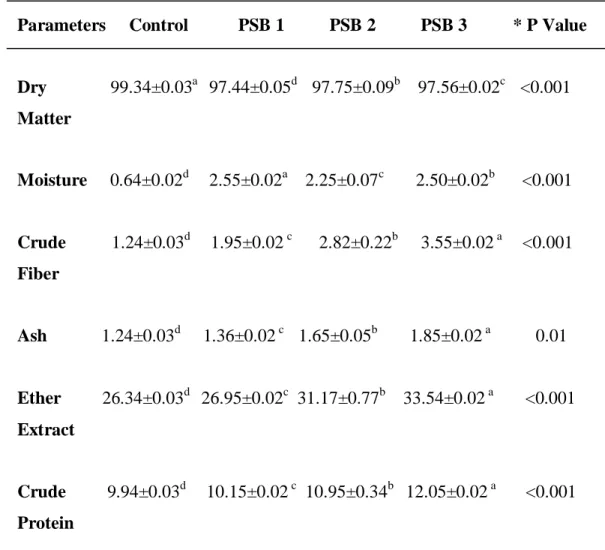I am grateful to my co-supervisor Mohammad Mozibul Haque, Assistant Professor, Department of Applied Food Science and Nutrition, CVASU, for his kind cooperation, valuable suggestions in carrying out the research work. Kazi Nazira Sharmin, Head and Associate Professor, Department of Applied Food Science and Nutrition, CVASU, for her valuable suggestions, cooperation and inspiration. I owe my special thanks to the director and the scientists associated with this research work of Poultry Research and Training Center (PRTC), Livestock Science and Nutrition Laboratory, Deptt.
Title of thesis: Nutritional evaluation of developed complementary food (cookie) with pumpkin seed meal for fortification. This is to report that according to the control, 18% of the content of the above dissertation is plagiarized and preferred according to the plagiarism policy and instructions of CASR, Chattogram Veterinary and Animal Sciences University. On a 7-point hedonic scale of sensory evaluation, the panelists accepted the pumpkin seed-based cookie.
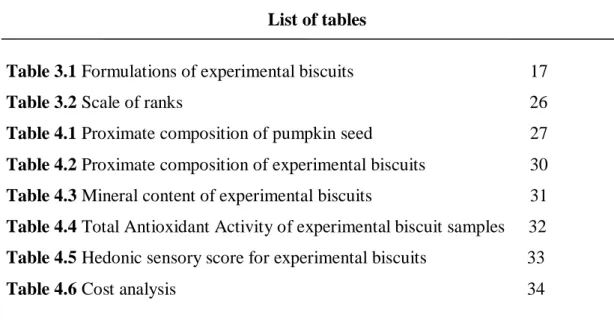
Introduction
- Objectives
- Antiquity and Spread of pumpkin
- Taxonomy of pumpkin
- Cultivation of pumpkin all around the world
- Pumpkin production scenario in Bangladesh
- The Nutritional Significance of Pumpkin Parts
- Plant
- Flowers
- Fruit
- Significance of Pumpkin Seeds
- Medicinal and Pharmacological Values of pumpkin Seed
- Cancer-Fighting Effects
- Could stop heart and blood vessel diseases
- Enhanced Prostate Health
- Help to Treat Infections in the Urinary Tract (UTIs)
- Reduce hair loss
- Act as Antidiabetic
- Promote mental growth of children
- Supplementary foods
- Supplementary foods from plant origin
- Utilizations of pumpkin as Ready-to-Eat Meals
Pumpkin fruits are heat sensitive and highly perishable in warmer climates (Chomicki et al., 2020). Pumpkin seeds are used all over the world for therapeutic purposes due to their abundance of nutrients and medicinal benefits (Kundu et al., 2014). Problems such as testosterone-related prostate growth (hyperplasia) can be prevented by consuming these minerals (Gossell et al., 2006).
These seeds and oil have been shown to reduce prostate enlargement due to their high zinc content (Yadav et al., 2010). They inhibit the enzymes (proteins) responsible for the breakdown of hair proteins and hair loss (Kanedi et al., 2017). Raw pumpkin seeds contain healthy omega-6 and omega-9 fatty acids, phytosterols, and vitamins E and K (Hashash et al., 2017).
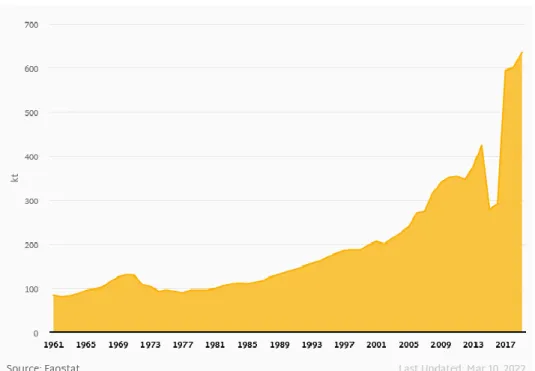
Materials and Methods
- Study Area
- Experimental design
- Collection
- Preparation of Pumpkin Seed flour
- Method used to prepare biscuits
- Nutritional evaluation of developed biscuits
- Physical characteristics of developed biscuits
- Proximate Analysis
- Mineral content analysis
- Determination of Antioxidant capacity by DPPH scavenging method
- Sensory Analysis
- Statistical Analysis
- Cost Analysis
After collecting the samples, it was used to make powder from or pumpkin seed flour. Then the four different biscuits such as control (without pumpkin seed flour supplement), 10% pumpkin seed biscuit (PSB 1), 20% pumpkin seed biscuit (PSB 2), 30% pumpkin seed biscuit (PSB 3) were prepared according to the formulation of Table 3.6. Samples of pumpkin seed flour and all types of crackers were taken for analysis of the proximate composition (dry matter, moisture, ash, crude fat, crude protein, crude fiber and carbohydrate), micro- and macronutrient composition, antioxidant activity and consumer acceptability of each product category.
Then all the powdered ingredients like wheat flour, PSP, common salt, baking powder were mixed together to make cookies. The diameter of cookies made with pumpkin seed flour measured 4.5 cm before baking and 4.7 cm after baking. With pumpkin seed flour and formulated cookies, a total of 5 samples were used for this analysis.
Organic solvents (such as methanol or chloroform) are used to dissolve food samples before the filtrate is separated, the filtrate is poured into funnels, drying of the final mixture produces the extracts, and the fat content is calculated. Estimating the difference between the nitrogen-free extract and the carbohydrate content (NFE), it was given as the deviation from 100 from the sum of the other nearby components. To determine the content of minerals in the biscuits, Traditional method for mineral analysis (Robert and Jerrad, 2017) was followed.
With a few minimal modifications to the method reported by Azlim et al. 2010), the dpph scavenging activity was used to assess the antioxidant susceptibility of the extracts. The decrease in the intensity of the samples compared to the DPPH standard solution served as a benchmark for the movement of scavenging. Alphabetic codes were randomly assigned to white ceramic plates used to serve PSB to the panelists.
The participants were instructed to score each of the four cookie samples based on color, smell, flavor, texture, crispiness and overall acceptability. Tukey's test was used using statistical software to see if there were statistically significant differences between the samples of cookies; the level of significance is (p 0.05). The total cost of the ingredients was used to calculate the pumpkin seed powder biscuit cost.
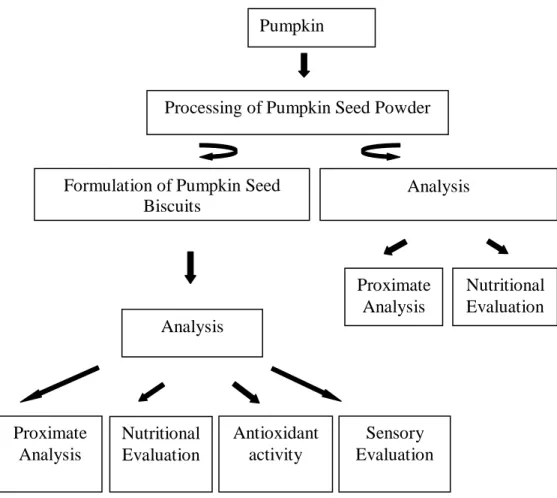
Result
- Proximate compositions of pumpkin seed
- Minerals content of pumpkin seed
- Nutrient Content of the Experimental Biscuits
- Moisture
- Crude Protein
- Ether extract
- Fiber
- Ash
- Dry Matter
- Energy
- Total Antioxidant Activity (TAA)
- Sensory Evaluation
- Cost Analysis
28 it can also be appreciated that pumpkin seeds are a rich source of potassium, phosphorus, zinc and iron. It was determined that the moisture content of the control sample was 0.64%, which was lower than the moisture content of the PSF1, PSF2 and the moisture content of the PSF3, respectively. So it is clear that the moisture content of the crackers is in a greater amount with the higher proportion of pumpkin seed flour in crackers.
29 we can say that cookies with a higher amount of pumpkin seeds obtained in this experiment are healthier than the control sample, since these cookies contained a higher amount of crude protein. So the control had the least, and the cookies with 30% pumpkin seed flour the most fiber. From Table 4.2, the ash concentration in the control sample was also lower than in PSB 1, PSB 2, and PSB 3, respectively.
The mineral content of the biscuit samples with control and PSB 1, PSB 2 and PSB 3 content is shown in table 4.3. The macro mineral such as calcium, magnesium, phosphorus, sodium, chloride, potassium content of pumpkin seed crackers was significantly (p<0.05) higher compared to control where the highest amount was. On the other hand, the copper content of supplemented biscuits had no significant difference (p>0.05) compared to control.
The mean score of TAA revealed that there is a significant difference (p<0.05) in case of all biscuits with pumpkin seed flour supplementation. Thus, the total antioxidant activity was found to be highest in biscuits containing a higher amount of pumpkin seed flour, followed by biscuits with a lower amount of pumpkin seed flour. Due to the improved appearance, color, taste, crispness and overall acceptability of the PSB 3 sample, the other samples received lower acceptability scores.
To develop the pumpkin seed powder that includes cookies, the ingredients for the cookie dough formulation were purchased from the local market as well as from the super store and from the tribal area of Rangamati.
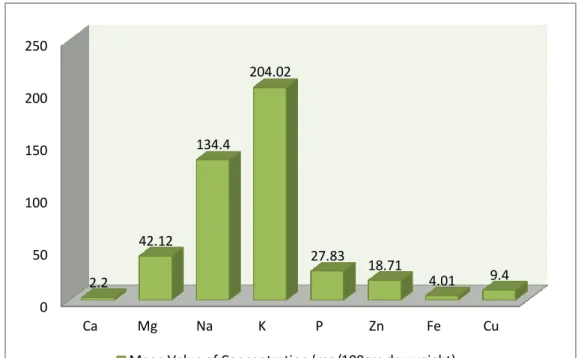
Discussion
- Proximate analysis of pumpkin seed
- Mineral content analysis of pumpkin seed
- Proximate composition of Experimental biscuits
- Mineral Analysis of Experimental biscuits
- Antioxidant Activity Analysis
- Sensory Analysis
The lower moisture content indicates that the samples made with a lower amount of pumpkin seed flour store better than the others. A significant difference (p<0.05) excised between the samples, this agrees well with the research work of (Aminuddin et al., 2019) who reported that the cookie supplementation with pumpkin seed flour also had a higher ash content of 1.65% for formulation 1 and 0.59. Considering the fat content or the ether extract, there was a significant difference (p<0.05) between the biscuits containing pumpkin seeds and the control sample.
The experimental biscuit sample PSB 3 made with the higher amount of pumpkin seed powder had the higher amount of fat content 33.54% than the respective lower amount of pumpkin seed incorporated biscuit sample PSB and PSB where the control sample has the lowest fat content 26.34%. These results confirm research by Kumari and Sindu (2019), in which the fat content of cookies with pumpkin seed flour is also higher according to the higher amount of pumpkin seed inclusion. Crude protein content was seen to be higher in pumpkin seed containing cookie samples than the control sample (9.94%).This observation is consistent with the study by Aminuddin et al. 2019), who prepared cookies with pumpkin seed cookies in different proportions.
With regard to the fiber content, there is a significant difference between the samples supplemented with pumpkin seed powder with a higher fiber content and 3.55 compared to the control sample 1.24%. These findings are consistent with the study by Kumari and Sindu (2019). Kanwal et al (2015) also analyzed the zinc content of biscuits enriched with 33% pumpkin seed flour and found that they contained 3.11 mg/100gm, which was higher than the control biscuits prepared from refined flour, which contained 0.96 mg/100gm. With the addition of pumpkin seed flour, the zinc content of cakes and biscuits increased significantly.
So, with the addition of pumpkin seed flour, the iron level of all the crackers increased dramatically. The results of the DPPH test indicate that the pumpkin seed powder incorporated cookie extract functioned as effective free red lime captured with the increased proportion of pumpkin seed powder incorporation (Table 4.4). This observation is consistent with the research work in which pumpkin seeds were also added to the wheat flour to make supplement cookie samples by Kaur and Sharma (2017).
The present findings are similar to the research work by Kaur and Sharma (2017) who observed lower acceptability scores of control compared to pumpkin seed powder containing cookies in terms of appearance, color and nutty flavor.
Conclusion
In this situation, this fortified biscuit could be a great way to get nutrients and in rural and tribal areas of the country. Based on the current study, the following ideas and opportunities for further research are provided. i) The present research could be conducted again with a large number of samples to back up the results of the experiments. ii) People who are struggling financially will benefit from it from a financial point of view. iii). Similar studies should be conducted on other store-bought seeds such as nigella, flaxseed, kidney beans and others. iv) Modern packaging and storage conditions will be made for pumpkin seed biscuits supplemented to preserve the quality of the product. v) Aromatic flavorings may be added to increase value. we).
Determination of the chemical composition of the nutritionally valuable parts of the male and female common West African freshwater crayfish (Sudananoutesafricanus). ADDITIONAL EFFECT OF PUMPKIN SEED ON MEMORY FUNCTION IN ANIMAL AND HUMAN MODELS UGC Reference No: MRP(S KLMG040/UGC-SWRO. Inhibition of testosterone-induced prostate hyperplasia in Sprague-dawley rats by pumpkin seed oil).
Determination of total phenolic, flavonoid, carotenoid and mineral content in peel, flesh and seed of pumpkin (Cucurbita maxima). Hair growth promoting activity of plant extracts of suruhan (Peperomia pellucida) in Rabbits, IOSR Journal of Pharmacy and Biological Sciences, Academia. Effect of incorporation of pumpkin (Cucurbita moshchata) powder and guar gum on the rheological properties of wheat flour.
Proximate composition of pumpkin seeds (Cucurbita Pepo) from Zimbabwe International Journal of Nutrition and Food Sciences. Effects of an oil-free hydroethanolic extract of pumpkin seed on frequency and severity of symptoms in men with benign prostatic hyperplasia: A pilot human study, Journal of Medicinal Food, US National Library of Medicine, National Institutes of Health. Changes in phenolic metabolites and biological removal activities of squash (Cucurbita moschata Duchesne ex Poir.) during bleaching.
46 Nishimura M, Ohkawara T, Sato H, Takeda H, Nishihira J. Pumpkin seed oil extracted from Cucurbita maxima Improves urinary disorder in human overactive bladder, Journal of Traditional and Complementary Medicine, US National Library of Medicine, National Institutes of Health.
Recommendation and future prospective
